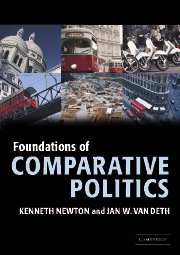Book contents
- Frontmatter
- Contents
- Acknowledgements
- List of briefings
- List of fact files
- List of controversies
- List of tables
- List of figures
- List of abbreviations and acronyms
- Key terms and concepts
- PART I The state: origins and development
- PART II The polity: structures and institutions
- 3 Constitutions
- 4 Presidential and parliamentary government
- 5 Multi-level government: international, national and sub-national
- 6 Policy making and legislating: executives and legislatures
- 7 Implementation: the public bureaucracy
- PART III Citizens, elites and interest mediation
- PART IV Policies and performance
- Glossary of key terms
- Index of names
- Index of subjects
6 - Policy making and legislating: executives and legislatures
- Frontmatter
- Contents
- Acknowledgements
- List of briefings
- List of fact files
- List of controversies
- List of tables
- List of figures
- List of abbreviations and acronyms
- Key terms and concepts
- PART I The state: origins and development
- PART II The polity: structures and institutions
- 3 Constitutions
- 4 Presidential and parliamentary government
- 5 Multi-level government: international, national and sub-national
- 6 Policy making and legislating: executives and legislatures
- 7 Implementation: the public bureaucracy
- PART III Citizens, elites and interest mediation
- PART IV Policies and performance
- Glossary of key terms
- Index of names
- Index of subjects
Summary
Governments are there to get things done. At the highest level, the most important things they do is formulate public policies and frame the laws of the land in accordance with these general policies, and at the heart of the policy and law making process lie the two main branches of government – the executive and the legislative assembly. This means that the study of the relations between executive and legislative branches is a topic that lies at the very core of comparative government.
Sometimes the executive and the legislative branches cooperate and act together, sometimes they fight and struggle for power. Since democratic constitutions deliberately divide the powers of government between different branches, so that they check and balance each other, there is little wrong with the fact that they sometimes fight. However, some analysts argue that all is not well with the classical system of checks and balances because the golden age of legislatures, some time in the nineteenth century, has given way to the twentieth-century supremacy of executives. What were once powerful elected assemblies with a great deal of control over the affairs of state are now reduced to little more than rubber stamps for decisions made by their executives – their presidents and prime ministers. If true, this has obvious implications for the state of democracy in modern executive-dominated government.
- Type
- Chapter
- Information
- Foundations of Comparative Politics , pp. 100 - 116Publisher: Cambridge University PressPrint publication year: 2005



